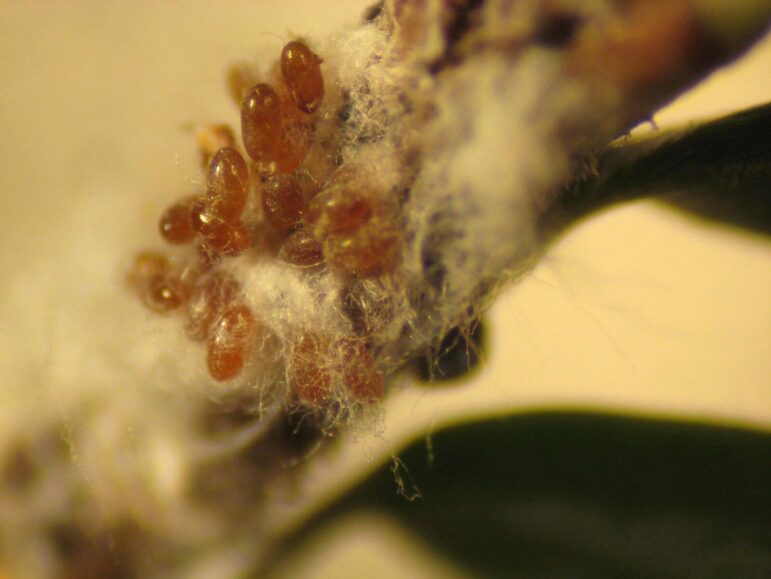
Shimat Joseph, University of Georgia
Hemlock woolly adelgid is killing Michigan’s eastern hemlock trees.By KARI EICKHOLDT
Capital News Service
LANSING — An invasive insect increasingly threatens one of the most important trees in Michigan and elsewhere in the Great Lakes region for storing the carbon that causes global warming.
Researchers have found that eastern hemlocks felled by the invasive woolly adelgid could emit 4.5 tons of carbon across almost two and a half football fields.
And that’s bad news for the environment, experts say.
The invader is a small, cotton-like insect from Asia that attacks eastern hemlocks by feeding on the nutrients and sap from the base of the needles on the underside of branches.
Eastern hemlocks take their sweet time to grow – between 250 and 300 years to reach maturity, according to the Natural Resources Conservation Service. They thrive in the shade and live for 800 years or more, which is why the insect infestation is worrisome.
Once the hemlock woolly adelgid kills an eastern hemlock, the tree no longer removes carbon dioxide from the atmosphere, said Peter Quinby, the founding executive director of Ancient Forest Exploration and Research, a group that works to bring forests back to their original character. As a tree decomposes, the dead wood releases that carbon back into the atmosphere.
“Not only are these big trees no longer absorbing the gas but also they are breaking down partly into (carbon dioxide), which adds (carbon dioxide) to the atmosphere,” he said. “So, it’s sort of a double whammy in that sense.”
Grand Valley State University has developed a trap to monitor the insect. It’s the size of a dinner plate and holds microscope slides. Vaseline is rubbed on the trap and placed under trees to catch insects that drop from them.
The insect was first reported in Virginia, in the 1950s. It has since migrated from Georgia up the East Coast into Canada and as far westward as Michigan, aided by climate warming, wildlife migration, logging and people moving firewood.
“The egg sacks of the hemlock woolly adelgid are very, very tiny,” said Nicole Mielewczyk, a biologist for the Canadian Food Inspection Agency. “But they’re very fluffy and really easily adhere to bird feathers. So, as birds are coming up from the South to migrate back into parts of Ontario or parts of Michigan or parts of New York, they are carrying hemlock woolly adelgid and then dropping them off as they come into new hemlock trees.”
A study this summer in the Forestry Chronicle found that hemlocks have little natural resistance to the invader. Across eastern North America, 90% of them can die within four to 15 years of infestation, regardless of their age and size.
To understand the long-term effects of the loss of eastern hemlocks, Danielle Ignace and Jesse Bellemare, professors of plant science at Smith College in Massachusetts, studied birch and hemlock-dominated plots at a college field station.
Their findings suggest that the decomposition of the fallen hemlock trees could deliver 4.5 tons of carbon per hectare into the atmosphere. One hectare is 2.47 acres.
Although it may take decades, the substantial loss of hemlocks has long-term consequential impacts on forest structure, function and carbon pools, researchers say.
Eastern hemlocks are also important to other ecosystem services such as nitrogen cycling, an essential process that keeps plant growth stable, Mielewczyk said.
“They have different microclimate environments and physical environments that can impact the forest ecosystem,” Mielewczyk said. “The death of hemlock trees would also make forests vulnerable to other invasive species that thrive in disturbed areas and therefore freely change the landscape of many forests within southern Ontario.”
“There are a few insecticides that are effective at knocking down major populations of hemlock woolly adelgid, controlling and keeping that low level,” Mielewczyk said. “In Canada, we don’t have many of those approved yet because there are different regulations for insecticides between Canada and the United States. We are working actively on more insecticide regulation, but it’s a really slow process, unfortunately.”
Other insects from Asia, such as the silver fly and the laricobius beetle feed on the hemlock woolly adelgid and can serve as biological control.
“What other members of the public can do is just keep an eye on the trees in their area,” Mielewczyk said. “They can take a look to see if they begin exhibiting any of the signs of the hemlock woolly adelgid infestation, which can include grayish green needles or defoliation.”
Other signs include discoloration of foliage, premature needle loss and premature bud and shoot dieback, which is death from the tip inward.
Kari Eickholdt writes for Great Lakes Echo.